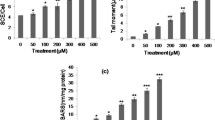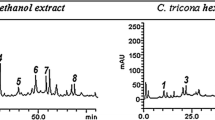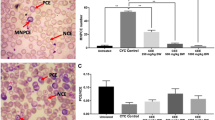Abstract
Cadmium is a modern environmental contaminant that is toxic and carcinogenic. Glycyrrhiza glabra is a traditional medicinal herb which grows in the various parts of the World. Recent studies demonstrated that G. glabra has antifungal, antimicrobial, antioxidant, and powerful antiinflammatory features. The purpose of this study was to investigate the genetic safety of extracts from G. glabra and its effects on cadmium (as CdCl2) induced genotoxicity. Therefore we evaluated the capability of G. glabra extract to inhibit the rate of micronucleus (MN), sister chromatid exchange (SCE) formations induced by CdCl2. Moreover, to assess the effects of G. glabra on cell viability and oxidative status, we performed 3-(4,5-dimethylthiazol-2-yl)-2,5-diphenyl tetrazolium bromide (MTT) and total antioxidant capacity (TAC) assays. Our results showed that there were significant increases (P < 0.05) in both SCE and MN frequencies of cultures treated with CdCl2 (5 ppm) as compared to controls. However, co-application of G. glabra extract (5, 10 and 20 ppm) and CdCl2 resulted in decreases of MN and SCE rates as compared to the group treated with CdCl2 alone. Again, the results of MTT and TAC assays clearly indicated dose dependent ameliorative effects of G. glabra extracts against CdCl2 toxicity. In conclusion, this study demonstrated for the first time that G. glabra extracts provided increased resistance of DNA against CdCl2 induced genetic and oxidative damage in human lymphocytes. So, the risk on target tissues of CdCl2 could be reduced and ensured early recovery from its toxicity.




Similar content being viewed by others
References
Abubakar MG, Taylor A, Ferns GAA (2003) Aluminium administration is associated with enhanced hepatic oxidant stress that may be offset by dietary vitamin E in the rat. Int J Exp Pathol 84:49–54
Ambawade SD, Kasture VS, Kasture SB (2001) Anxiolytic activity of Glycyrrhiza glabra L. J Nat Rem 2:130–134
Anon (2005) Glycyrrhiza glabra. Monograph. Altern Med Rev 10: 230–237
Baltina LA, Flekhter OB, Nigmatullina LR, Boreko EI, Pavlova NI, Nikolaeva SN, Savinova OV, Tolstikov GA (2003) Lupane triterpenes and derivatives with antiviral activity. Bioorg Med Chem Lett 13:3549–3552
Berti G, Averbeck D (2006) Cadmium: cellular effects, modifications of biomolecules, modulation of DNA repair and genotoxic consequences (a review). Biochimie 88:1549–1559
Ceremelli C, Portolani M, Cotombari B, Castelli M, Baggio G, Galatulas I et al (1996) Activity of glycyrrhizin and its diasterioisomers against two new human herpes virus: HHV- 6 and HHV-7. Phyto Res 10:527–528
Cerutti P, Ghosh R, Oya Y, Amstad P (1994) The role of the cellular antioxidant defense in oxidant carcinogenesis. Environ Health Perspect 102:123–129
Chandrasekaran CV, Sundarajan K, Gupta A, Srikanth HS, Edwin J, Agarwal A (2011) Evaluation of the genotoxic potential of standardized extract of Glycyrrhiza glabra (GutGard™). Regul Toxicol Pharmacol 61:373–380
Degraeve N (1981) Carcinogenic, teratogenic and mutagenic effects of cadmium. Mutat Res 86:115–135
Donma O, Donma M (2005) Cadmium, lead and phytochemicals. Med Hypotheses 65:699–702
Duxbury T (1985) Ecological aspects of heavy metal responses in microorganisms. Adv Microb Ecol 8:185–235
Edenharder R, Worf-Wandelburg A, Decker M, Platt KL (1999) Antimutagenic effects and possible mechanisms of action of vitamins and related compounds against genotoxic heterocyclic amines from cooked food. Mutat Res 444:235–248
Erel O (2004) A novel automated direct measurement method for total antioxidant capacity using a new generation, more stable ABTS radical cation. Clin Biochem 37:277–285
Esparza L, Gomez M, Romeu M, Mulero M, Sanchez DJ, Mallol J, Domingo JL (2003) Aluminum-induced pro-oxidant effects in rats: protective role of exogenous melatonin. J Pineal Res 35:32–39
Evans HJ, O’Riordan ML (1975) Human peripheral blood lymphocytes for the analysis of chromosome aberrations in mutagen tests. Mutat Res 31:135–148
Fenech M (1993) The cytokinesis blocks micronucleus technique: a detailed description on the method and its application to genotoxicity studies in human population. Mutat Res 285:35–44
Fenwick GR, Lutomski J, Nieman C (1990) Liquorice, Glycyrrhiza glabra L. Composition, uses and analysis. Food Chem 38:119–143
Fojtova M, Kovarik A (2000) Genotoxic effect of cadmium is associated with apoptotic changes in tobacco cells. Plant Cell Environ 23:531–537
Fotakis G, Cemeli E, Anderson D, Timbrell JA (2005) Cadmium chloride-induced DNA and lysosomal damage in a hepatoma cell line. Toxicol In Vitro 19:481–489
Foulkes EC (1994) Epithelial transport pf heavy metals. Adv Comp Eviron Physiol 20:55–84
Fuhrman B, Buch S, Vaya J, Belinky PA, Coleman R, Hayek T, Aviram M (1997) Licorice extract and its major polyphenol glabridin protect low-density lipoprotein against lipid peroxidation: in vitro and ex vivo studies in humans and in atherosclerotic apolipoprotein E-deficient mice. Am J Clin Nutr 66:267–275
Fukui H, Goto K, Tabata M (1988) Two antimicrobial flavanones from the leaves of Glycyrrhiza glabra. Chem Pharm Bull 36:4174–4176
Galitskií LA, Barnaulov OD, Zaretskií BV, Malkov MI, Konenkov SI, Gol’m NP, Tomakov VS, Ogarkov PI, Batskov SS (1997) Effect of phytotherapy on the prevention and elimination of hepatotoxic responses in patients with pulmonary tuberculosis, carriers of hepatitis B virus markers. Probl Tuberk 4:35–38
Geyikoglu F, Turkez H, Keles MS (2005) The role of fruit juices in the prevention of aluminum sulphate toxicity in human blood in vitro. Fres Environ Bull 14:878–883
Gibson MR (1978) Glycyrrhiza in old and new perspectives. Lloydia 41:348–354
Haraguchi H, Yoshida N, Ishikawa H, Tamura Y, Mizutani K, Kinoshita T (2000) Protection of mitochondrial functions against oxidative stresses by isoflavans from Glycyrrhiza glabra. J Pharm Pharmacol 52:219–223
Hayashi H, Yasuma M, Hiraoka N, Ikeshiro Y, Yamamoto H, Yesilada E, Sezik E, Honda G, Tabata M (1996) Flavonoid variation in the leaves of Glycyrrhiza glabra. Phytochemistry 42:701–704
Hikino H (1985). Recent Research on Oriental Medicinal Plants. In: Wagner H, Hikino H, and Farnsworth NR, editors. Economic and Medicinal Plant Research. London: Academic Press. pp 53–58
Hirabayashi K, Iwata S, Matsumoto H, Mori T, Shibata S, Baba M et al (1991) Antiviral activity of glycyrrhizin and its modified compounds against human immunodeficiency virus type 1 and herpes simplex type 1 in vitro. Chem Pharm Bull 39:112–115
IARC (1993) Cadmium and cadmium compounds (group 1). In: International agency for research on cancer monographs on the evaluation of carcinogenic risks to humans, vol 58. Beryllium, cadmium, mercury, and exposures in the glass manufacturing industry. Summary of data reported and evalution, Lyon, pp 119–237
Jiang W, Liu D, Hou W (2001) Hyperaccumulation of cadmium by roots, bulbs and shoots of garlic (Allium sativum L.). Bioresour Technol 76:9–13
Jonak C, Nakagami H, Hirt H (2004) Heavy metal stress. Activation of distinct mitogen- activated protein kinase pathways by copper and cadmium. Plant Physiol 136:3276–3283
Kaur P, Kaur S, Kumar N, Singh B, Kumar S (2009) Evaluation of antigenotoxic activity of isoliquiritin apioside from Glycyrrhiza glabra L. Toxicol In Vitro 23:680–686
Khalaf I, Vlase L, Lazar D, Corciova A, Ivanescu B, Lazar MI (2010) Hplc-uv-ms study of polyphenolsfrom Glycyrrhıza glabra. Farmacia 58:416–421
Kidd P (1997) Glutathione: systemic protectant against oxidative and free radical damage. Altern Med Rev 2:155–176
Lata S, Saxena RS, Kumar A, Kakkar S, Srivastava VK, Saxena KK (1999) Comparative antipyretic activity of Ocimum sanctum, Glycyrrhiza glabra and aspirin in experimentally induced pyrexia in rats. Indian J Pharmacol 31:71–75
Lee CH, Park SW, Kım YS, Kang SS, Kım JA, Lee SH, Lee SM (2007) Protective mechanism of glycyrrhizin on acute liver injury induced by carbon tetrachloride in mice. Biol Pharm Bull 30:1898–1904
Leung A (1980) Encyclopedia of common natural ingredients used in food drugs and cosmetics. Wiley, New York, pp 220–223
Lewerenz V, Hanelt S, Nastevska C, El-Bahay C, Ro¨hrdanz E, Kahl R (2003) Antioxidants protect primary rat hepatocyte cultures against acetaminophen-induced DNA strand breaks but not against acetaminophen-induced cytotoxicity. Toxicol 191:179–187
Loser E (1980) A 2 year oral carcinogenicity study with cadmium on rats. Cancer Lett 9:191–198
Misra RR, Smith GT, Waalkes MP (1998) Evaluation or the direct genotoxic potential of cadmium in four different rodent cell lines. Toxicol 126:103–114
Mosmann T (1983) Rapid colorimetric assay for cellular growth and survival: application to proliferation and cytotoxicity assay. J Immunol Meth 65:55–63
Nadkarni AK (1998) Indian materia medica. Popular Prakashan, Bombay
Nomura T, Fukai T (1998) Progress in the Chemistry of Organic Natural Products. In Herz W, Kirby GW, Moore RE, Steglich W, Tamm C, (eds) Springer, Wien-New York, 73:1–140
Nzengue Y, Steiman R, Garrel C, Lefèbvre E, Guiraud P (2008) Oxidative stress and DNA damage induced by cadmium in the human keratinocyte HaCaT cell line: role of glutathione in the resistance to cadmium. Toxicol 243:193–206
Olukoga A, Donaldson D (1998) Historical perspectives on health. The history of liquorice: the plant, its extract, cultivation, commercialisation and etymology. J R Soc Health 118:300–304
Rajesh MG, Paul Beena, Latha MS (2000) Efficacy of Kamilari in alcoholic liver cirrhosis. Antiseptic 97:320–321
Rao MV, Chinoy NJ, Suthar MB, Rajvanshi MI (2001) Role of ascorbic acid on mercuric chloride-induced genotoxicity in human blood cultures. Toxicol In Vitro 15:649–654
Rauchensteiner F, Matsumura Y, Yamamoto Y, Yamaji S, Tani T (2005) Analysis and comparison of Radix glycyrrhizae (licorice) from Europe and China by capillary-zone electrophoresis (CZE). J Pharm Biomed Anal 38:594–600
Rossman TG, Roy NK, Lin WC (1992) Is cadmium genotoxic? In: GF Nordberg, Alessio L, Herber RFM (eds.) Cadmium in the human environment: toxicity and carcinogenicity. Lyon: IARC Scientific Publication No. 118, pp 367–373
Schulz V, Hänsel R, Tyler VE (1998) Rational Phytotherapy. A Physicians’ Guide to Herbal Medicine. Springer-Verlag: Berlin pp 160–187
Seoane AI, Dulout FN (2001) Gentoxicity ability of cadmium, chromium and nickel salts studied by kinetochore staining in the cytogenesisblocked micronucleus assay. Mutat Res 490:99–106
Shibano M, Matsumoto Y, Kusano G, Shibata T (1996) Nat Med 50:273–283
Shibata S (2000) A drug over the millennia: pharmacognosy, chemistry, and pharmacology licorice. Yakugaku Zasshi 120:849–862
Shon MY, Choi SD, Kahng GG, Nam SH, Sung NJ (2004) Antimutagenic, antioxidant and free radical scavenging activity of ethyl acetate extracts from white, yellow and red onions. Food Chem Toxicol 42:659–666
Sun Y (1990) Free radicals, antioxidant enzymes, and carcinogenesis. Free Radic Biol Med 8:583–599
Turkez H (2011) The role of ascorbic acid on titanium dioxide-induced genetic damage assessed by the comet assay and cytogenetic tests. Exp Toxicol Pathol 63:453–457
Turkez H, Geyikoglu F (2010a) The anti-genotoxic effect of taurine on aluminum sulphate induced DNA damage in human peripheral lymphocytes. IUFS J Biol 69:25–32
Turkez H, Geyikoglu F (2010b) Boric acid: a potential chemoprotective agent against aflatoxin b(1) toxicity in human blood. Cytotechnology 62:157–165
Turkez H, Geyikoglu F, Keles MS (2005) Biochemical response to colloidal bismuth subcitrate: dose-time effect. Biol Trace Elem Res 105:151–158
Turkez H, Geyikoglu F, Mokhtar YI, Togar B (2012a) Eicosapentaenoic acid protects against 2,3,7,8-tetrachlorodibenzop-dioxin-induced hepatic toxicity in cultured rat hepatocytes. Cytotechnology 64:15–25
Turkez H, Geyikoglu F, Tatar A, Keles MS, Kaplan I (2012b) The effects of some boron compounds against heavy metal toxicity in human blood. Exp Toxicol Pathol 64:93–101
Turkez H, Geyikoğlu F, Dirican E, Tatar A (2012c) In vitro studies on chemoprotective effect of borax against aflatoxin B1-induced genetic damage in human lymphocytes. Cytotechnology 64:607–612
Turkez H, Geyikoglu F, Yousef MI, Celik K, Bakir TO (2012d) Ameliorative effect of supplementation with L: -glutamine on oxidative stress, DNA damage, cell viability and hepatotoxicity induced by 2,3,7,8-tetrachlorodibenzo-p-dioxin in rat hepatocyte culture. Cytotechnology 64:687–699
Valko M, Morris H, Cronin MT (2005) Metals, toxicity and oxidative stress. Curr Med Chem 12:1161–1208
Waisberg M, Joseph P, Hale B, Beyermann D (2003) Molecular and celular mechanisms of cadmium carcinogenesis. Toxicology 192:95–117
Wang ZY, Athar M, Bickers DR (2000) Licorice in foods and herbal drugs: chemistry, pharmacology, toxicology and uses. In: Mazza G, Oomah BD (eds) Herbs, Botanicals & Teas. Technomic Publishing Co. Inc, Lancaster, pp 321–353
Wang SS, Chen L, Xıa SK (2007) Cadmium is acutely toxic for murine hepatocytes: effects on intracellular free Ca 2 + homeostasis. Physiol Res 56:193–201
Watanabe M, Shiroishi K, Nishino H, Shinmura T, Murase H, Shoji T, Naruse Y, Kagamimori S (1986) An experimental study on the longterm effect of cadmium in mice fed cadmium-polluted rice with special reference to the effect of repeated reproductive cycles. Environ Res 40:25–46
Watjen W, Beyersmann D (2004) Cadmium-induced apoptosis in C6 glioma cells: influence of oxidative stress. Biometals 17:65–78
Yoshida H, Watanabe K, Takahashi S, Ichikawa K (2010) Protective effects of HFE7A, mouse anti-human/mouse Fas monoclonal antibody against acute and lethal hepatic injury induced by Jo2. Cytotechnology 62:313–323
Zeng L, Lou ZC, Zhang RY (1991) Quality evaluation of Chinese licorice. Yao Xue Xue Bao 26:788–793
Zhang Y, Xiao H (1998) Antagonistic effect of calcium, zinc and selenium against cadmium induced chromosomal aberrations and micronuclei in root cells of Hordeum vulgare. Mutat Res 420:1–6
Zhang YX, Yang XL (1994) The toxic effects of cadmium on cell division and chromosomal morphology of Hordeum vulgare. Mutat Res 312:121–126
Author information
Authors and Affiliations
Corresponding author
Rights and permissions
About this article
Cite this article
Dirican, E., Turkez, H. In vitro studies on protective effect of Glycyrrhiza glabra root extracts against cadmium-induced genetic and oxidative damage in human lymphocytes. Cytotechnology 66, 9–16 (2014). https://doi.org/10.1007/s10616-012-9531-5
Received:
Accepted:
Published:
Issue Date:
DOI: https://doi.org/10.1007/s10616-012-9531-5




